LA GOMERA
Plants and Animals

Plants and Animals

Popular destinations SPAIN
| Andalusia | Catalonia | Costa blanca |
| Costa brava | Costa del sol | El hierro |
| Formentera | Fuerteventura | Gran canaria |
| Ibiza | La gomera | La palma |
| Lanzarote | Mallorca | Menorca |
| Tenerife |
Plants and Animals
Plants
In the five vegetation zones on La Gomera, there are more than 2000 plant species, including 700 endemic species.
In the prehistoric Parque Nacional de Garajonay, thanks to the permanent dew and high humidity, more than 450 species of plants and trees grow, often of very large size. In the middle of the park there is an ancient laurel forest ('laurisilva') with trees up to 20 metres high. The laurisilva vegetation is further characterised by cedars, tree heather, juniper, willows and an undergrowth of mosses, holly and ferns. The El Bosque del Cedro forest in particular is a typical example of this type of vegetation.
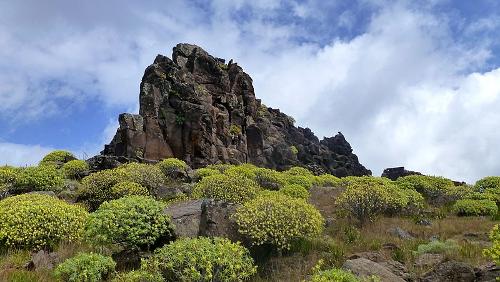 Vegetation La GomeraPhoto Puusterke CC 4.0 no changes made
Vegetation La GomeraPhoto Puusterke CC 4.0 no changes made
From the foot of the mountains to the waterline grows the Canary Island palm, whose sap is thickened into honey ('miel de palma'). Canary Island palms can grow to a height of 25 metres and the tree was declared the symbol of the archipelago some years ago. There are more than 120,000 of these palms on La Gomera, more than on all the other Canary Islands put together.
Agalán is home to the island's last dragon blood tree, the approximately 150-year-old Drago de Agalán. The dragon tree is in fact a lily species that can become hundreds of years old.
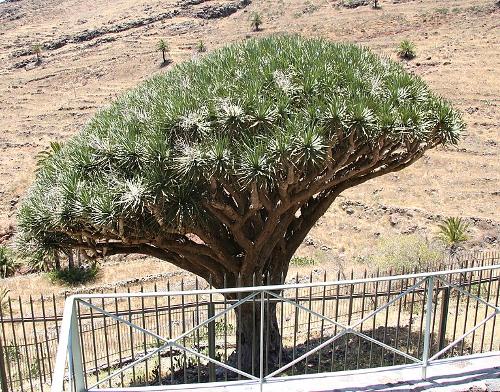 Drago de Agalan, La GomeraPhoto: Michael Wolf, Penig no changes made
Drago de Agalan, La GomeraPhoto: Michael Wolf, Penig no changes made
Scattered over the island grow tamarisks, thorny, almost leafless plants, Canary Island pines, Cistus monspeliensis (a type of rockrose), sedges, various species of aeonium (succulents), agaves, gale trees, cistus, woodland pansies, Canary Island redstarts, Hierro-goose thistle, yellow affodil, Neapolitan garlic, fig cacti, candlestick spurge or Euphorbia, Indian bay tree, Canary wormwood, Canary stinging palmetto, Canary bush daisy, bicoloured rocket, wild fennel, tabaiba, tajinaste, sea lavender, leech, three-leaf clove, willow thistle, lemon bush climbing ferns, yellow teline gomera, which flowers exclusively on La Gomera and Woodwardia radicans, the largest wild fern in the Canary Islands.
LAUREL TREES
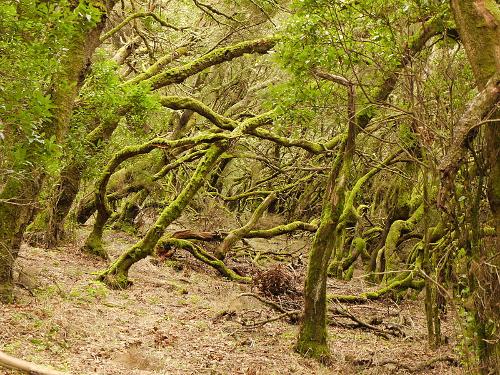 Laurel Forest in Park National Garajonay, La GomeraPhoto: China Crisis CC 3.0 no changes made
Laurel Forest in Park National Garajonay, La GomeraPhoto: China Crisis CC 3.0 no changes made
Millions of years ago, laurel forests were scattered all over the world. The Ice Age caused them to disappear almost everywhere, and they only survived on the Canary Islands, Madeira, the Azores and Cape Verde.
Before the arrival of the Spaniards, almost all of La Gomera was covered with laurel forest. After the conquest by the Spanish, entire areas were cut down for the planting of the lucrative sugar cane.
In the Parque National de Garajonay, different species of the laurel family are found. On the European mainland, the Laurus azorica can only be seen as a shrub, on La Gomera it can grow up to a 25 metre high tree. The Ocotea foetens or skunk laurel gives off an unpleasant smell if the tree is damaged. The sap of the Persea indica or Madeira mahogany is poisonous.
Animals
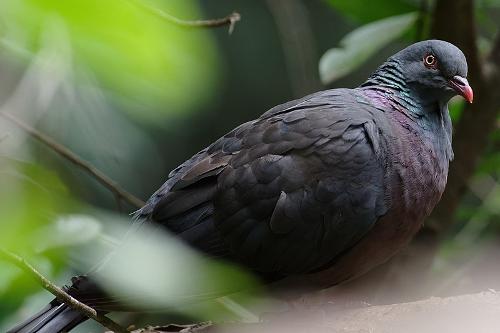 Bolles Laurel Dove, La GomeraPhoto: Hobbyfotowiki in the public domain
Bolles Laurel Dove, La GomeraPhoto: Hobbyfotowiki in the public domain
The Parque Nacional de Garajonay is cut through by a large number of ravines, which form a habitat for many rare birds, such as the Bolles laurel dove, which is only found on La Gomera. Invertebrates (e.g. monarch butterfly, rhinoceros beetle and European mantis shrimp) can be found in many variations, vertebrates much less, only some rabbits, hedgehogs and rats. Furthermore, there are many species of (song) birds, including blackbirds, blue tits, the green-browed canary, ravens, kestrels, small eagles and owls. Special birds are the Canary spotted woodpecker and the Canary beech finch, which is threatened with extinction. In the west and centre of the island, the partridge is common. On La Gomera, 68 species of birds nest and more than 240 species of migratory birds.
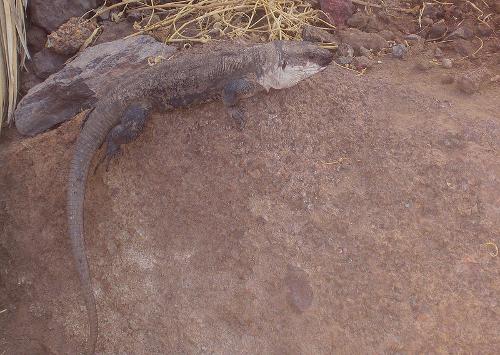 Large Giant Lizard, La GomeraPhoto: Nanosanches in the public domain
Large Giant Lizard, La GomeraPhoto: Nanosanches in the public domain
Snakes and scorpions do not occur on La Gomera. Small lizards and geckos do occur, as well as indigenous species such as the large giant lizard (Gallotia simonyi stehlini), the Canary gecko (Tarentola boettgeri) and the black Gomerian lizard (Tarentola gomerensis).
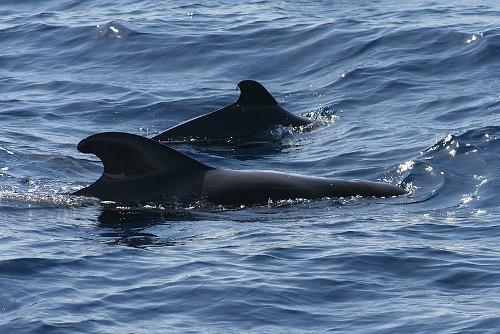 Whalewatching, La gomeraPhoto: Ahisgett CC 2.0 no changes made
Whalewatching, La gomeraPhoto: Ahisgett CC 2.0 no changes made
Whale-watching boat trips are organised from the west of La Gomera. With a little luck, one can see fin whales, killer whales, sperm whales, pilot whales and dolphins. Divers often encounter stingrays, moray eels, trumpet fish, parrot fish and puffer fish. More rare are sunfish, hammerhead sharks and manta rays.
Sources
Canarische Eilanden
Van Reemst
Evers, K. / Canarische eilanden : Tenerife, La Gomera, El Hierro, La Palma, Gran Canaria, Fuerteventura, Lanzarote
Gottmer,
Leibl, M. / Gomera & Hierro
Van Reemst
Lipps, S. / La Gomera
ANWB
Lipps, S. / Wandelgids La Gomera en El Hierro
ANWB
Murphy, P. / Canarische eilanden
Kosmos-Z&K
Renouf, N. / Canarische eilanden
Kosmos-Z&K
Rokebrand, R. / Reishandboek Tenerife
Elmar
Schulze, D. / La Gomera
Deltas
Simonis, D. / Tenerife & La Gomera
Kosmos-Z&K
Williams, C. / Tenerife, including La Gomera
Rough Guides
CIA - World Factbook
BBC - Country Profiles
Copyright: Team The World of Info